 | ||
Platforms AndroidArcadeGame BoyGame Boy AdvanceGame Boy ColorGameCubeiOSNintendo 3DSNintendo 64Nintendo DSWiiWii U Designers Nintendo, HAL Laboratory, Genyo Takeda, Satoshi Tajiri, Shigeru Miyamoto, Junichi Masuda, Ken Sugimori Genres Adventure game, Fighting game, Puzzle video game, Role-playing video game, Strategy video game Publishers Nintendo, The Pokémon Company, Niantic, Wizards of the Coast | ||
Pokémon is a series of video games developed by Game Freak and Creatures Inc. and published by Nintendo as part of the Pokémon media franchise. First released in 1996 in Japan for the Game Boy, the main series of role-playing video games (RPGs) has continued on each generation of Nintendo's handhelds.
Contents
- Generations
- First generation 19961999
- Second generation 19992002
- Third generation 20022006
- Fourth generation 20062010
- Fifth generation 20102013
- Sixth generation 20132016
- Seventh generation 2016present
- Gameplay
- Handheld games
- Console games
- Arcade games
- Mobile games
- Appearances in other games
- Smash Bros series
- Reception and legacy
- References
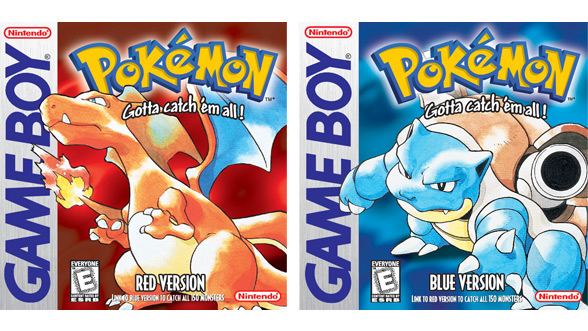
The games are commonly released in pairs—each with slight variations—with an enhanced remake of the games usually released a few years after the original versions. While the main series consists of role-playing games, spinoffs encompass other genres, such as action role-playing, puzzle, and digital pet games.
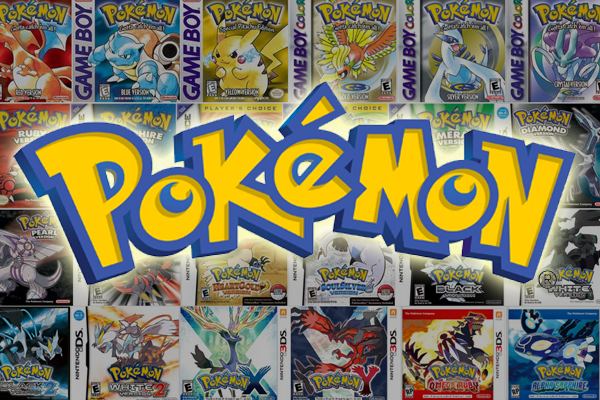
As of February 2016, more than 279 million Pokémon games have been sold worldwide, more than 200 million of which from the main series. This makes Pokémon the third best-selling video game franchise, behind Nintendo's own Mario franchise and the Tetris series of block puzzle games. The franchise's mascot is Pikachu.
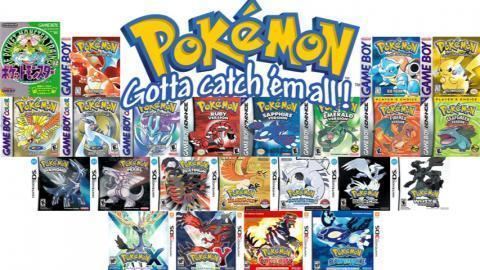
Generations
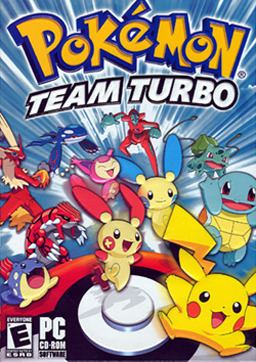
All of the licensed Pokémon properties overseen by The Pokémon Company are divided roughly by generation. These generations are roughly chronological divisions by release; when an official sequel in the main role-playing game series is released that features new Pokémon, characters, and possibly new gameplay concepts, that sequel is considered the start of a new generation of the franchise. The main games and their spin-offs, the anime, manga and trading card game are all updated with the new Pokémon properties each time a new generation begins. The franchise began its seventh generation with Pokémon Sun and Moon, which were released worldwide on November 18, 2016.
First generation (1996–1999)
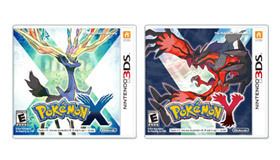
The original Pokémon games are Japanese role-playing video games (RPGs) with an element of strategy, and were created by Satoshi Tajiri for the Game Boy. These role-playing games, and their sequels, remakes, and English language translations, are still considered the "main" 'Pokémon' games, and the games with which most fans of the series are familiar.

The Pokémon series began with the release of Pocket Monsters Red and Green for the Game Boy in Japan. When these games proved extremely popular, an enhanced Blue version was released sometime after, and the Blue version was reprogrammed as Pokémon Red and Blue for international release. The original Green version was never released outside Japan. Afterwards, a second enhanced remake, Pokémon Yellow, was released to use the color palette of the Game Boy Color and more of a stylistic resemblance to the popular Pokémon anime. This first generation of games introduced the original 151 species of Pokémon (in National Pokédex order, encompassing all Pokémon from Bulbasaur to Mew), as well as the basic game concepts of capturing, training, battling and trading Pokémon with both computer and human players. These versions of the games take place within the fictional Kanto region, though the name "Kanto" was not used until the second generation. Spin-off first-generation titles include Pokémon Pinball; an adaptation of the Pokémon Trading Card Game for Game Boy Color; an on-rails photography simulator for Nintendo 64 titled Pokémon Snap; a Nintendo 64 Pokémon-themed adaptation of Tetris Attack, Pokémon Puzzle League. A 3D Nintendo 64 incarnation of the handheld RPGs' battle system, Pokémon Stadium; and a co-starring role for several species in the Nintendo 64 fighting game Super Smash Bros.. At the Nintendo Space World in 2000, a game was revealed briefly with Meowth and Team Rocket singing a song. This was one of the earliest introductions of the Pokémon Togepi and Bellossom. This game was called Meowth's Party, but was never turned into a playable game. Instead, the song/video was played at the end of one Pokémon episode, and a CD was made for retail in Japan for a limited time.
Second generation (1999–2002)

The second generation of Pokémon video games began in 1999 with the Japanese release of Pokémon Gold and Silver for the Game Boy Color, with Australia and North America getting the game in October 2000 and European release date of April 2001. Like the previous generation, an enhanced version titled Pokémon Crystal was later released.
This generation introduced 100 new species of Pokémon (starting with Chikorita and ending with Celebi), for a total of 251 Pokémon to collect, train, and battle. New gameplay features include a day-and-night system (reflecting the time of the day in the real world) which influences events in the game; full use of the Game Boy Color's color palette; an improved interface and upgraded inventory system; better balance in the collection of Pokémon and their moves, statistics and equippable items (a new addition); the addition of two new Pokémon types (Dark and Steel) to better balance the strengths and weaknesses of each Pokémon; Pokémon breeding; and a new region named Johto. After exploring Johto, the player can travel east to explore the adjacent Kanto region.
Spin-off games in the second-generation include Pokémon Puzzle Challenge, the adaptation of Pokémon Puzzle League—a puzzle game created by Zoppf industries—made specifically for the Game Boy Color; the Nintendo 64 pet simulator Hey You, Pikachu!; the Pokémon Stadium sequel, Pokémon Stadium 2, for Nintendo 64; several Pokémon mini-games for the e-Reader; and a co-starring role for several Pokémon species in the Super Smash Bros. sequel Super Smash Bros. Melee for the GameCube. The Pokémon mini was a handheld game console released in December 2001 in Japan and 2002 in Europe and North America.
Third generation (2002–2006)
Pokémon entered its third generation with the 2002 release of Pokémon Ruby and Sapphire for Game Boy Advance and continued with the Game Boy Advance remakes of Pokémon Red and Green, Pokémon FireRed and LeafGreen (Red and Green representing the original Japanese first generation games; territories outside Japan instead saw releases of Red and Blue). An enhanced remake of Pokémon Ruby and Sapphire titled Pokémon Emerald followed after.
The third generation introduced 135 new Pokémon (starting with Treecko and ending with Deoxys) for a total of 386 species. It also features a more visually detailed environment compared to previous games, "natures" which affect Pokémon stats, a new 2-on-2 Pokémon battling mechanic, a special ability system applying to each Pokémon in battle, the Pokémon Contest sub-game, the new region of Hoenn, and the ability to select the protagonist's gender. However, this generation also garnered some criticism for leaving out several gameplay features, including the day-and-night system introduced in the previous generation (which was removed due to internal-battery save problems), and it was also the first installment that encouraged the player to collect merely a selected assortment of the total number of Pokémon rather than every existing species (202 out of 386 species are catchable in the Ruby and Sapphire versions).
Third-generation spin-off titles include Pokémon Pinball: Ruby & Sapphire for Game Boy Advance; Pokémon Mystery Dungeon: Blue Rescue Team and Red Rescue Team for Game Boy Advance and Nintendo DS; Pokémon Dash, Pokémon Trozei! and Pokémon Ranger for Nintendo DS; Pokémon Channel and Pokémon Box: Ruby & Sapphire for GameCube; and two RPGs for the GameCube, consisting of the games Pokémon Colosseum and Pokémon XD: Gale of Darkness.
Fourth generation (2006–2010)
In 2006, Japan began the fourth generation of the franchise with the release of Pokémon Diamond and Pearl for Nintendo DS. The games were subsequently released in North America on April 22, 2007 and in Australia on June 21, 2007. The game was then later released in the UK and Europe on July 27, 2007. Other main series games in the fourth generation include Pokémon Platinum, a director's cut version of Diamond and Pearl in the same vein as Pokémon Yellow, Crystal, and Emerald. It was released for the Nintendo DS in Japan on September 13, 2008, in North America on March 22, 2009, and in Australia and Europe on May 14, 2009 and May 22, 2009 respectively. It was also announced that the Generation II games Pokémon Gold and Silver would be remade for the Nintendo DS as Pokémon HeartGold and SoulSilver. First released in Japan on September 12, 2009, the games were later released to North America, Australia, and Europe during March 2010.
The fourth generation introduces another 107 new species of Pokémon (starting with Turtwig and ending with Arceus), bringing the number of Pokémon species to 493. This generation is the first to have 3D graphics in a main series game, although it is still a mixture of both 3D graphics and sprites. New gameplay concepts include a restructured move-classification system, online multiplayer trading and battling via Nintendo Wi-Fi Connection, the return (and expansion) of the second generation's day-and-night system, the expansion of the third generation's Pokémon Contests into "Super Contests", and the new region of Sinnoh, which has an underground component for multiplayer gameplay in addition to the main overworld. HeartGold and SoulSilver also introduced the Pokeathelon to the Johto region, which consists of many Pokémon based sporting events making use of the stylus.
Spin-off games in the fourth generation include the Pokémon Stadium follow-up Pokémon Battle Revolution for Wii (which has Wi-Fi connectivity as well), Pokémon Ranger: Shadows of Almia and Pokémon Ranger: Guardian Signs for Nintendo DS, Pokémon Mystery Dungeon: Explorers of Time and Explorers of Darkness and their sister game, Explorers of Sky all for the Nintendo DS, and a co-starring role for Pikachu, Jigglypuff, Lucario, and a Pokémon Trainer (who uses Squirtle, Ivysaur, and Charizard for fighting) in the 2008 Wii fighter Super Smash Bros. Brawl.
Fifth generation (2010–2013)
The fifth generation of Pokémon began on September 18, 2010 with the release of Pokémon Black and White in Japan. They were then released in North America, Europe, and Australia in March 2011. They were released on the Nintendo DS, the same console as its predecessing generation.
The games take place in the Unova region. New features include the C-Gear, a feature where players can use Wi-Fi options and customizations; two new battle methods ("Triple Battles", where three Pokémon are sent out at once, and Rotation Battles, where three Pokémon are also sent out at the same time, but the trainer can switch one Pokémon out of the three that are present); "Battle Tests", where trainers battle each other to see who has stronger Pokémon; the Pokémon Musicals (similar to Pokémon Contests), which have trainers use their Pokémon to dance in a theater with other Pokémon; and the ability to never waste Technical Machines (TMs), even when found the first time.
This generation introduced a total of 156 new Pokémon (beginning with Victini and ending with Genesect), the most of any generation so far. It was also the first generation where the first new Pokémon in National Pokédex order (Victini) is not a starter. It also introduced another new feature, the seasons, from which two Pokémon (Deerling and Sawsbuck) represent them. Unlike previous generations, which would introduce some species of Pokémon that were evolutionary relatives of older-generation Pokémon, the fifth generation's selection was all-original, in an attempt to make the primary versions feel like a brand-new game.
The other core series games, and the additions to Black and White, titled Pokémon Black 2 and White 2, are direct sequels. They take place in the Unova region two years later, and were released in Japan on June 23, 2012 and in North America, Australia, and Europe in October of that year for Nintendo DS. They are somewhat different of their predecessors; there are different protagonist trainers, and many of the other important characters have changed as well. The games also introduced a new feature, the "Pokémon World Tournament", where trainers can battle gym leaders and champions from older regions, including Unova. The games also broke the tradition of releasing a third version as the addition to the primary versions.
Spin-off fifth generation games include sequels Pokémon Rumble Blast and Pokémon Mystery Dungeon: Gates to Infinity for Nintendo 3DS, PokéPark 2: Wonders Beyond for Wii, and Pokémon Rumble U for Wii U, a downloadable game. Others include Learn with Pokémon: Typing Adventure (a typing game) and Pokémon Conquest (a crossover game) for Nintendo DS, and downloadable reference applications Pokédex 3D, Pokédex 3D Pro (for Nintendo 3DS), and Pokédex for iOS (for iOS devices), which allows players to view information of Pokémon species while they have 3D models.
Sixth generation (2013–2016)
On December 24, 2012, Japanese magazine Nintendo Dream posted a greetings card sent out by Game Freak. In the card, Junichi Masuda exclaimed that during 2013, they intend to further evolve the world of Pokémon. On December 29, 2012, a new Pokémon Black 2 and White 2 commercial aired in Japan, and ending with a message, informing Pokémon fans that the latest news would be announced on January 8, 2013. On January 4, 2013, both the Japanese and English official Pokémon website confirmed that an announcement would be made on January 8. On January 7, 2013, the official Japanese website explained that the Nintendo president, Satoru Iwata would hold a 10-minute "Pokémon Direct" video conference to announce the big Pokémon news. On January 8, 2013, Satoru Iwata announced the sixth generation of Pokémon, with the new paired games, Pokémon X and Y, which were released on the Nintendo 3DS on October 12, 2013 worldwide. The X and Y games are rendered in full 3D; however, only select parts of the game can be displayed in stereoscopic 3D. The video introduced the player characters, the starter Pokémon; Grass-type Chespin (Japanese: Harimaron (ハリマロン)), the Fire-type Fennekin (Japanese: Fokko (フォッコ)), and the Water-type Froakie (Japanese: Keromatsu (ケロマツ)), and two other Pokémon, not named until later; a bird-like Pokémon called Yveltal (イベルタル, Iberutaru) having a shape similar to the letter Y and a deer-like Pokémon called Xerneas (ゼルネアス, Zeruneasu) with X-shapes in its eyes. A month later, Sylveon (Japanese: Nymphia (ニンフィア, Ninfia)), a new evolved form of Eevee belonging to the games' new Fairy Type was revealed.
This generation introduced a total of 72 new Pokémon, the new Fairy type, Mega Evolution, the Kalos region, Trainer customization, Super Training, and three new battle modes: Sky Battles, Horde Encounters, and Inverse Battle. This generation is also the first to be compatible with Pokémon Bank.
Greninja, the final evolved form of Froakie, would later go on to represent the sixth generation of Pokémon in the hit fighting game, Super Smash Bros. for Nintendo 3DS and Wii U.
On May 7, 2014, Nintendo revealed the games Pokémon Omega Ruby and Alpha Sapphire in a teaser trailer, remakes of the third generation games Pokémon Ruby and Sapphire. They were released worldwide in November 2014.
On August 26, 2014, Pokkén Tournament was announced and was released on July 16, 2015 in Japanese arcades and was released on March 18, 2016 worldwide for Wii U. It was developed by Bandai Namco Entertainment. In July 2016, Niantic and Nintendo released a free-to-play augmented-reality game titled 'Pokémon Go' which was released on Android and iOS devices.
Seventh generation (2016–present)
During a Nintendo Direct presentation on February 26, 2016, two new Pokémon titles were announced, titled Pokémon Sun and Moon. The games were released on November 18, 2016 in Japan, North America and Australia, and in Europe on November 23, 2016. The games were the first since the second generation to be backwards-compatible with other titles, including Pokémon X and Y; Pokémon Omega Ruby and Alpha Sapphire; and the Virtual Console re-releases of Pokemon Red, Blue, and Yellow.
Gameplay
One of the consistent aspects of most "Pokémon" games—spanning from Pokémon Red and Blue on the Game Boy to the Nintendo 3DS games Pokémon Sun and Moon—is the choice of one of three different Pokémon at the start of the player's adventures; these three are often labeled "starter Pokémon". Players can choose a Grass-type, a Fire-type, or a Water-type, Pokémon indigenous to that particular region. For example, in Pokémon Red and Blue, the player has the choice of starting with Bulbasaur, Charmander, or Squirtle. The exception to this rule is Pokémon Yellow, where players are given a Pikachu, an Electric-type mouse Pokémon, famous for being the mascot of the Pokémon media franchise; unique to Pokémon Yellow, the three starter Pokémon from Red and Blue can be obtained during the quest by a single player.
Another consistent aspect is that the player's rival will always choose the type that has a type advantage over the player's chosen Pokémon as his or her starter Pokémon(excluding Sun and Moon). For instance, if the player picks the Fire-type Charmander, the rival will always pick the Water-type Squirtle. This does not affect the first battle between the rivals, as they can only use Normal-type attacks at this point, meaning that they cannot exploit weaknesses. The exception to this is again Pokémon Yellow, in which the rival picks Eevee, a Normal-type Pokémon with multiple evolutions. Sun and Moon also is an exception is this rule, as the rival picks the starter weak toward the player's starter, with the Pokémon that has the type advantage going to a trainer in the Champion battle.
However, in Pokémon Black and White, there are two rivals; one picks the Pokémon with a type advantage over the player's chosen Pokémon, while the other chooses the Pokémon with the type disadvantage. In Pokémon Diamond, Pearl and Platinum, another Trainer chooses the Pokémon with a type disadvantage to the player's chosen Pokémon, but never battles the player; instead, this character battles alongside the player as a tag partner in certain situations.
The situation is similar in Pokémon X and Y, but there are four rivals. Two of them receive the starter Pokémon in an arrangement similar to Pokémon Black and White, but the other two have completely different Pokémon.
Handheld games
Console games
Arcade games
Mobile games
Appearances in other games
Several Pokémon PC games were released for Microsoft Windows and Macintosh. Games from the franchise were also released exclusively in Japan for Sega consoles Pico and Advanced Pico Beena. Pokémon are also in Mario Artist: Paint Studio for Nintendo 64DD as pasteable stickers, and they also appear in Picross NP Vol. 1 for the Super Nintendo Entertainment System.
Smash Bros. series
In the Super Smash Bros. series, Pikachu, Ivysaur, Squirtle, Charizard, Jigglypuff, Pichu, Mewtwo, Lucario and Greninja are/ have been playable characters. Pikachu and Jigglypuff are introduced in Super Smash Bros., and are also featured in Super Smash Bros. Melee for the GameCube, alongside Pichu and Mewtwo. In Super Smash Bros. Brawl, Mewtwo and Pichu are not featured as playable characters, although Squirtle, Ivysaur, and Charizard make their first playable appearances as part of the Pokémon Trainer character, while Lucario appears as a separate character. Greninja made its first appearance in Super Smash Bros. for Nintendo 3DS and Wii U, Charizard is a standalone character, and Mewtwo returns as a downloadable content character. Rayquaza is featured as a boss enemy in Super Smash Bros. Brawl. The series features Poké Balls as items, which, when used by a player, make a random Pokémon appear including Piplup, Bonsly, and Munchlax, with various effects on the game, and Super Smash Bros. for Nintendo 3DS and Wii U have Master Balls, which function like Poké Balls but only summon a rare Pokémon (like Mew, Palkia, and Genesect) or Goldeen. Several Pokémon also appear as stage hazards/in stages, including Rayquaza, Ho-Oh and Manaphy.
Reception and legacy
The series has sold over 279 million units (inclusive of spin-off titles; 210 million for the mainline Pokémon games) as of February 29, 2016, giving it the distinction of being one of the best-selling video game series in history. Guinness World Records awarded the Pokémon series eight records in Guinness World Records: Gamer's Edition 2008, including "Most Successful RPG Series of All Time", "Game Series With the Most Spin-Off Movies" and "Most Photosensitive Epileptic Seizures Caused by a TV Show". The Pokémon video game series is the basis of the Pokémon franchise, which includes the Pokémon anime, the Pokémon Trading Card Game, the Pokémon manga, and various toys. The anime series has run for over 900 episodes, accompanied by 19 feature films, with a twentieth in production. The trading card game and its expansion sets have grown to around 3,000 unique cards in total, and continue to draw a healthy player base to its official international tournaments. The extent of global toy and merchandise sales since 1996 cover such broad markets and high quantities that they are simply beyond estimation.
IGN ranked Pokémon as the 17th greatest desired game series: "the basic gameplay premise boasts solid, addictive play mechanics, and several of the handheld RPGs deserve to be in every gamer's collection. GamesRadar listed Pokémon as the No. 1 Nintendo game "not made by Nintendo", stating that having to catch each Pokémon made the games addictive.
